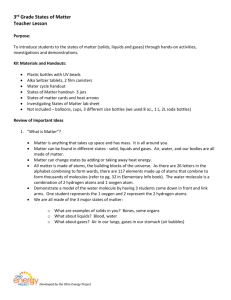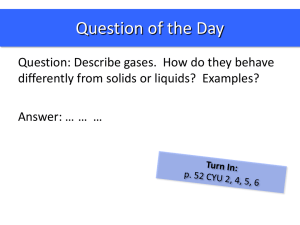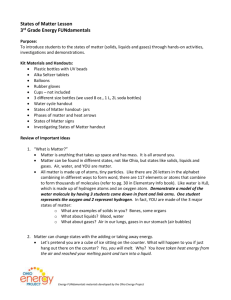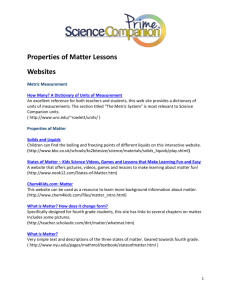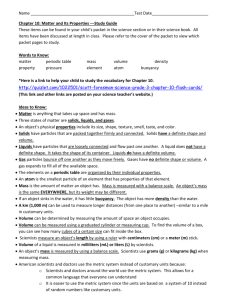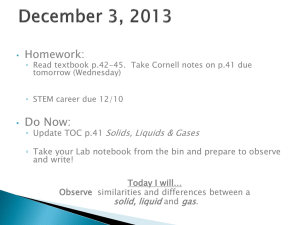States of Matter Teacher Lesson
advertisement
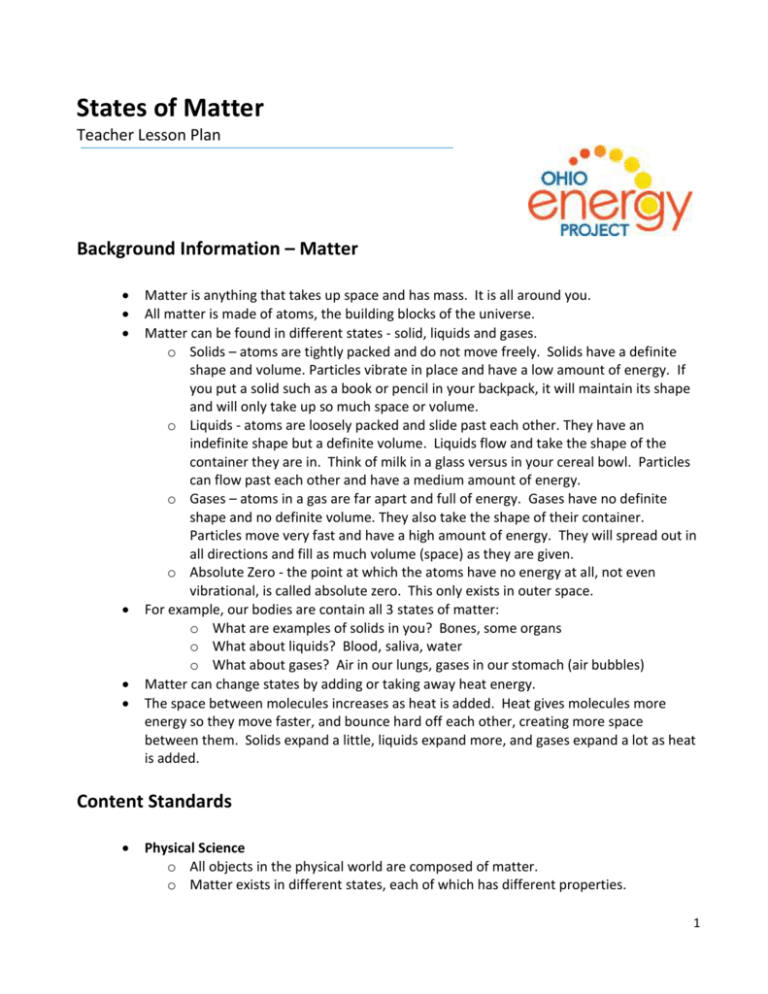
States of Matter Teacher Lesson Plan Background Information – Matter Matter is anything that takes up space and has mass. It is all around you. All matter is made of atoms, the building blocks of the universe. Matter can be found in different states - solid, liquids and gases. o Solids – atoms are tightly packed and do not move freely. Solids have a definite shape and volume. Particles vibrate in place and have a low amount of energy. If you put a solid such as a book or pencil in your backpack, it will maintain its shape and will only take up so much space or volume. o Liquids - atoms are loosely packed and slide past each other. They have an indefinite shape but a definite volume. Liquids flow and take the shape of the container they are in. Think of milk in a glass versus in your cereal bowl. Particles can flow past each other and have a medium amount of energy. o Gases – atoms in a gas are far apart and full of energy. Gases have no definite shape and no definite volume. They also take the shape of their container. Particles move very fast and have a high amount of energy. They will spread out in all directions and fill as much volume (space) as they are given. o Absolute Zero - the point at which the atoms have no energy at all, not even vibrational, is called absolute zero. This only exists in outer space. For example, our bodies are contain all 3 states of matter: o What are examples of solids in you? Bones, some organs o What about liquids? Blood, saliva, water o What about gases? Air in our lungs, gases in our stomach (air bubbles) Matter can change states by adding or taking away heat energy. The space between molecules increases as heat is added. Heat gives molecules more energy so they move faster, and bounce hard off each other, creating more space between them. Solids expand a little, liquids expand more, and gases expand a lot as heat is added. Content Standards Physical Science o All objects in the physical world are composed of matter. o Matter exists in different states, each of which has different properties. 1 Student Activities LESSON 1: Solids, Liquids & Gases Introduction Materials: Plastic Bottles with UV beads States of Matter Cards Definite/Indefinite Volume & Shape Cards High/Medium/Low Energy Cards Student Worksheet-States of Matter Not included: Three bottles with different volumes, balloons with different shapes or sizes Procedure: 1. States of Matter Review Begin completion of the States of Matter Lab Sheet Look around the classroom and think of home. What are some examples of solids? We can change the shape of a solid, but we have to use energy to do it. For example, we can crush a rock. We changed the shape, but we had to use energy to do it. The same with a piece of paper. We can crumble or fold it and change its shape, but we did it with energy. Look around the classroom and think of home. What are some examples of liquids? Using three different size plastic bottles, you can measure the same amount of liquid (colored water works great) and pour that same amount in an 8 oz. bottle, 1 L and a 2 L bottle. They can see that liquids look different in each container, reinforcing that liquids take the shape of their container, but have a definite volume, which was measured. Look around the classroom and think of home. What are some examples of gases? Using different size balloons, show the students with an equal amount of blowing in each of the balloons, that gases have no definite shape or volume and will fill as much space as possible. 2. Energy in a Bottle Show the solid sign – students should be barely moving their bottles showing vibrating beads with low energy. Show the liquid sign – students should be moving the bottles more demonstrating flowing beads with medium energy. Show the gas sign – students should be moving the bottles rapidly with high energy. Get them going by changing the words quickly so they have to act fast. 3. “Acting Out” the States of Matter Students use their bodies to act out the three states of matter while standing in place. 2 Solid – vibrate in place Liquid – move their bodies with flowing arms Gas – shake entire body with lots of energy 4. States of Matter Wall Graphic Using the graphics, assemble the properties for solids, liquids and gases, including the definite/indefinite shape and volume cards and the high, medium and low energy cards. 5. Complete section on States of Matter Lab Sheet LESSON 2: Life Cycle of an Ice Cube Background Information Everything in nature seeks balance. Heat seeks balance, too. Energy flows from hotter places (high energy) to colder places (lower energy) and from hotter substances to colder substances. Lesson Materials: Energy In/Energy Out Arrows Melt/Boil-Evaporate/Freeze/Condensation Arrows Water Cycle Handout Optional-If you have a heat source in your classroom, you can put the ice cube on a hot plate and show all three states of matter. Student Worksheet-States of Matter Procedure: 1. Water can change states by adding or taking away heat energy. Using the states of matter cards, have students use the word arrows to show how energy is transferred to change states of matter. Melting – if an ice cube is left on the counter, the ice will take heat ENERGY IN (show with red arrow on solid ice to liquid) from the air and will MELT to form water. Evaporation/Boiling- if the water is left on the counter, it will take ENERGY IN from the air and EVAPORATE. If the cube is put on a hotplate, the water will take ENERGY IN (show with red arrow on liquid to gas) and will BOIL and turn into a gas or steam. Condensation - if we take ENERGY OUT (show with red arrow on gas to liquid) of a GAS, it will become a liquid again or CONDENSE. Freezing – if we take ENERGY OUT (show with red arrow on liquid to solid) of a liquid to go back to an ice cube, the liquid will have to go into the freezer to remove even more heat energy. The water will reach the freezing point and become an ice cube. 2. Add the melting/boiling/freezing/condensation arrows to the graphics you started in Lesson 1. 3. Add the Energy In/Energy Out Arrows to the graphics you started in Lesson 1. 3 4. Water Cycle Handout- How do all these energy transfers happen in nature? Through the water cycle, this is the natural sequence through which water passes into the atmosphere as water vapor, comes down as precipitation in liquid or solid form, and ultimately returns to the atmosphere through evaporation. 5. Complete the Life Cycle of an Ice Cube section on the States of Matter Lab Sheet. LESSON 3: Demonstrations of Solids, Liquids and Gases Lesson Materials: Film Canisters and Alka-Seltzer tablets Not included: 2L bottle, white vinegar, balloon Procedure: 1. Mystery Tablet Divide the students into groups and give them a cup and ½ of an Alka-Seltzer tablet. Have them fill the cup about a ¼ full with water. Have them record on their lab sheet what they predict will happen when you drop the mystery tablet into the water. At one time, ask all the groups to drop the tablet into the water. Ask them to put their hand over the cup so they can feel the gas. What is this process similar to? Like the bubbles of a soda when you open it. To show what can happen when a gas is contained, you can take a film canister and fill it ½ full with water (liquid) and ½ of an Alka-Seltzer tablet (solid). Close the lid and wait. The canister will pop due to the formation of gas. Be sure to use good lab safety protocol and wear glasses or safety goggles and do not put the canister near your students. 2. Blow Up a Balloon Measure a cup of white vinegar into a 2 liter bottle. Add 2 tablespoons of baking soda directly into the balloon. Using a funnel helps. Quickly put the balloon over the bottle and watch the balloon enlarge showing the gas formation in the bottle and balloon. You may need to shake the balloon to get the baking soda to fall into the bottle. A solid (baking soda) was added to a liquid (vinegar) and produced a gas (carbon dioxide). 3. Other Activities: Making Jell-O reinforce the three states of matter. It starts with a solid (the powder), add water (liquid) and through boiling, a gas is produced. After putting it in the refrigerator (taking energy out), the Jell-O has turned back into a solid. Make a Venn diagram, showing the relationship between states of matter. Visit the OEP website to print a Venn diagram handout. 4 “Who Has It?” – Interactive card game that reinforces the states of matter and the terms in the lesson. For example, one student would have a card that says – Who has something that says, this is a gas to a liquid? Another student would have the word condensation. This game can be found on the OEP website. “What’s-the-Matter?” Party - Make root beer floats. Start with ice cream (solid), add root beer (liquid), and you get the carbonation in the root beer (carbon dioxide gas). 5
